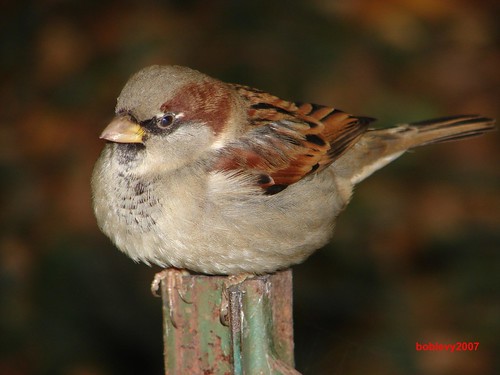tags: house sparrow, Passer domesticus, birds, Image of the Day
House sparrow, Passer domesticus, which I usually refer to as an English Sparrow, in honor of where it originally came from. This is a young male that lives in Central Park, NYC.
Image: Bob Levy, author of Club George. [larger view].
More below the fold;
The photographer writes: I enjoyed the series of sparrow photos very much but I did not recall seeing the House Sparrow, [which is] often taken for granted. These birds intrigue me for a number of reasons not the least of which is the history of how they came to be here. About 100 birds were transported from England and released in Brooklyn, New York in the fall of 1851 [and the] spring of 1852 according to The Birds of North America: House Sparrow, No. 12, 1992. In 100 Birds and How They Got Their Names, Diana Wells says that these sparrows had been imported to control the population of a certain caterpillar. (Unfortunately she does not specify which insect it was. If any one out there in Cyberland knows please post it here).
Some of the new arrivals were transported to other parts of the US. Subsequently more were brought from Europe and in a surprisingly short time House Sparrows had spread over about half of North America. A public debate about the possible extermination of the species initiated by feuding ornithologists got so heated says Diana Wells that it came to be called the "Sparrow War." The outcome of that conflict is obvious: House Sparrows have survived and thrived to become as ubiquitous as a bird can be.
The specimen pictured is a fellow who frequents the Shakespeare Garden in Central Park. He recognizes my whistle meant to summon two Northern Cardinals of long acquaintance I call Mama and Papa Castle. The House Sparrow knows my whistling means a peanut is about to be released into the local environs and more often than not beats the cardinals to the free lunch intended for them. But hey, I am an equal opportunity bird feeder. "Bon appetite," House Sparrow.
- Log in to post comments


One thing that I find really interesting about this species is that the size of the black bib on a male's chest is influenced by social dominance. Development of color patterns(sexual selection or otherwise) really interests me, and coloration is especially interesting in birds because of the diverse mechanisms (carotenoids, structural color, hormonal control of melanin, etc). I know this is a ubiquitous and sometimes controversial species, but I do get a kick out of watching their acrobatics, I've gotten to know a couple of groups on campus pretty well and they are nothing if not entertaining! Thanks, as always, for the great picture!
The other thing that is cool about that black bib is that, even though it is enhanced in the spring (breeding) plumage, there is no molting necessary to make it bigger and blacker.
Look at the bib in that male above. There is black there, but if you look closely you see that the black feathers have gray tips. This is a bird in fresh fall plumage. As the winter continues, the gray tips wear off, exposing the black more and more, until the spring bird has a gorgeous black bib. And he didn't even have to lose some feathers (a risky move in the coldest and hungriest part of the year) to make himself more attractive!
Yeah, I love these little masked bandits!
Hey, Albatrossity: Thanks for the tip. (Pun intended). I had never before noted that the tips of the Hosue Sparrow bib feathers are gray and wear away. Duh. I need to look at my own images a little more carefully.
To Bob Levy
You're quite welcome, and thank you for the nice picture!
House Sparrows aren't the only birds that use this trick. Reed Buntings and Snow Buntings, as well as Harris' Sparrows, get more colorful in the spring not by molting, but by feather wear. If you don't happen to have any of those birds in your neighborhood, you can also look at your local Northern Cardinals right now. Most of them, while still red, are a bit dull-looking. But by mid-February (at least here in Kansas) they will be bright red, and that is again due to the abrasion of dull gray/brown feather tips on the ends of bright red feathers.
Albatrossity - thanks for that explanation. I reviewed a paper on this a couple of years ago, and didn't totally understand what was going on. I do remember them discussing that the adult males preen their bibs, so they can make them look bigger.
Ah, it was this paper: Jensen, H., Svorkmo-Lundberg, T., Ringsby, T. H. and Sæther, B.-E. 2006. Environmental influence and cohort effects in a sexual ornament in the house sparrow, (Passer domesticus). Oikos 114: 212-224.
These guys have a metapopulation on islands off the Norwegian coast that they follow every year, and can then do cool stuff, like write cool models.
Bob
Albatrossity. I have indeed noticed how gray the backs of Northern Cardinals can become. On some of the males it can be quite pronounced. Hmmm...maybe I have a shot of this in the archives....